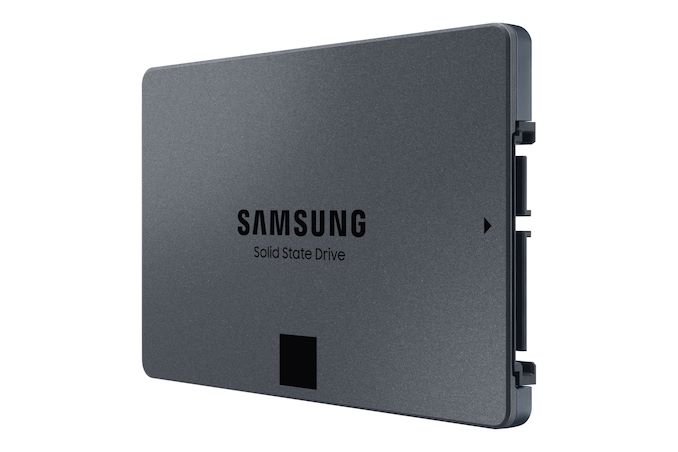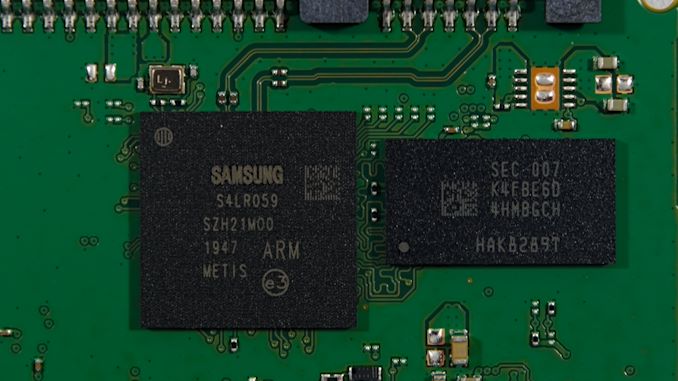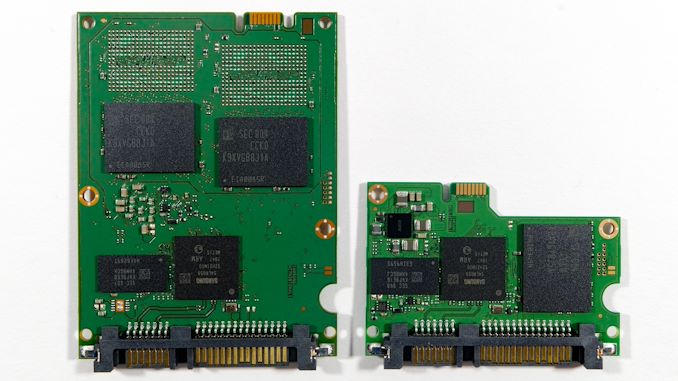The Samsung 870 QVO (1TB & 4TB) SSD Review: QLC Refreshed
by Billy Tallis on June 30, 2020 11:40 AM EST
A year and a half ago, Samsung introduced the first consumer SATA SSDs to use QLC NAND flash memory, squeezing an extra bit into each memory cell, yielding the 860 QVO to join the existing lineup of 860 EVO and PRO. Samsung's second-generation QLC NAND is now ready, and the 870 QVO is the first 870 model to be launched.
The industry put a lot of effort into preparing for the arrival of QLC NAND: beefing up error correction to compensate for lower write endurance, and tuning cache algorithms on consumer drives to forestall dealing with lower performance after SLC caches run out. But in spite of all the work it took to make QLC SSDs viable, they haven't made much of a splash and definitely aren't displacing TLC from the market yet.
The new Samsung 870 QVO SSDs arrive into a market landscape that doesn't look all that different to what the 860 QVO faced at the end of 2018. Samsung is no longer the only brand selling consumer SATA SSDs with QLC NAND, but it's not a big club. Most of the other QLC SATA drives are so low-end that the manufacturers won't commit to using any particular memory inside, and they're using whatever is cheapest at the moment. Some months, there's more to be saved by going with a DRAMless controller and TLC NAND that fell off the back of a truck, rather than using Samsung's strategy of pairing theoretically cheaper QLC NAND with a solid controller.
QLC NAND has had a bit more of an impact in the NVMe SSD market, where a few more brands are experimenting with using QLC to make big drives cheaper, rather than simply making cheap drives even cheaper. That's the same goal that Samsung had for the 860 QVO and now the 870 QVO: bringing multi-TB SSDs into the mainstream. Samsung's most visible contribution to that goal will be the introduction of the first 8TB consumer SATA SSD: the 8TB 870 QVO. That model is due to arrive a little bit later in August, and we don't have a sample yet. Today, we're looking at the 1TB and 4TB capacities of the 870 QVO.
Samsung MKX controller and LPDDR4 DRAM
The Samsung 870 QVO is an incremental update to the 860 QVO. The QLC NAND has been updated from Samsung's 64-layer V-NAND to their 92-layer V-NAND. For their NVMe product line, this change produced the 970 EVO Plus as a successor to the 970 EVO without even updating the controller, and the 970 PRO didn't get updated at all. The 870 QVO does bring a controller update, replacing the MJX with the MKX in Samsung's long line of SATA SSD controllers. Samsung hasn't disclosed any particular enhancements to their controller or firmware architecture, and we suspect this iteration is a more minor update than the last one. We know that the older MJX controller was already capable of supporting 8TB drive capacities, so that wasn't the driving force for this controller update.
| Samsung 870 QVO Specifications | ||||||
| Capacity | 1 TB | 2 TB | 4 TB | 8 TB | ||
| Form Factor | 2.5" 7mm SATA | |||||
| Controller | Samsung MKX | |||||
| NAND Flash | Samsung 1Tbit 92L 3D QLC | |||||
| LPDDR4 DRAM | 1 GB | 2 GB | 4 GB | 8 GB | ||
| Max SLC Cache Size | 42 GB | 78 GB | 78 GB | 78 GB | ||
| Sequential Read | 560 MB/s | |||||
| Sequential Write |
SLC | 530 MB/s | ||||
| QLC | 80 MB/s | 160 MB/s | ||||
| Random Read IOPS (4kB) |
QD1 | 11k (SLC) 5k (QLC) |
11k (SLC) 5k (QLC) |
|||
| QD32 | 98k (SLC) 45k (QLC) |
98k (SLC) 74k (QLC) |
||||
| Random Write IOPS (4kB) |
QD1 | 35k (SLC) 22k (QLC) |
35k (SLC) 34k (QLC) |
|||
| QD32 | 88k (SLC) 22k (QLC) |
88k (SLC) 42k (QLC) |
||||
| Power Consumption |
Read | 2.1 W | 2.1 W | 2.2 W | 2.4 W | |
| Write | 2.2 W | 3.0 W | 3.2 W | 3.3 W | ||
| Idle | 30 mW | 30 mW | 35 mW | 45 mW | ||
| DevSlp | 3 mW | 4 mW | 7 mW | 10 mW | ||
| Warranty | 3 years | |||||
| Write Endurance | 360 TB 0.3 DWPD |
720 TB 0.3 DWPD |
1440 TB 0.3 DWPD |
2880 TB 0.3 DWPD |
||
| MSRP | $129.99 (13¢/GB) |
$249.99 (12¢/GB) |
$499.99 (12¢/GB) |
TBA | ||
Samsung continues to provide more detailed performance specifications than any other consumer SSD vendor. The big top-line numbers that everybody reports are hardly worth mentioning for a SATA drive; almost any drive can saturate the 6Gbps interface under ideal conditions, with random or sequential reads or writes at a high enough queue depth. Samsung goes the extra mile to provide specs for performance at queue depth 1, and performance after the SLC cache runs out. Some of those numbers look pretty brutal: sequential write speeds dropping to a mere 80MB/s for the 1TB model, and even random reads are considerably slower when accessing QLC data rather than the SLC cache. But overall, these specs are very similar to the 860 QVO. Random write performance at QD1 appears to have taken a bit of a hit, but everywhere else performance for the 870 QVO is rated to be equal or slightly better than its predecessor.
The 870 QVO product line still starts at 1TB, the minimum size needed to put 8 controller channels to work when using 1024Gbit NAND dies. That smallest capacity model comes with some significant performance deficits relative to the multi-TB models, in much the same fashion as 256GB TLC drives fall behind their larger counterparts, or 512GB capacities for high-performance NVMe SSDs. The most notable limitations of the 1TB 870 QVO are the post-cache write speed of 80 MB/s compared to 160 MB/s, and the cache size that is almost halved. Together that means the 1TB model is more at risk of exhibiting unacceptable performance when the SLC write cache runs out, but at 42GB this model's cache can still handle more writes than many users perform in an entire day of desktop usage.
Samsung's warranty for the 870 QVO is 0.3 drive writes per day for 3 years. This is comparable to many low-end consumer TLC drives and a step up from most other consumer QLC drives that are rated for 0.1 to 0.15 DWPD (sometimes over a 5-year warranty period, but that's still fewer total writes than the 870 QVO is rated for).
Introductory MSRPs for the 870 QVO are reduced from what the 860 QVO debuted at, with $50 off the 2TB and $100 off the 4TB. But that merely puts the 870 QVO's launch MSRP on par with the current street prices for the 860 QVO. And because it's Samsung, the pricing isn't low enough to rule out comparing against mainstream TLC SATA SSDs and entry-level NVMe SSDs, especially for the lower capacities.
In a way, that's good for this review, because the 870 QVO doesn't have much direct competition in the form of other large QLC SATA drives. Most of the SSDs that are considerably cheaper than the 860/870 QVOs are DRAMless SSDs, usually TLC but occasionally QLC. The cheapest entry-level NVMe SSDs are all either DRAMless with TLC, or use QLC with a more mainstream controller.
For this review, we are comparing the 870 QVO against the following:
- The 870 QVO's immediate predecessor, the 860 QVO
- The ADATA Ultimate SU750 and Patriot P200, two different DRAMless TLC SATA drives. The SU750 uses a Realtek controller and the 2TB P200 used a Maxio controller, both budget options.
- The Crucial MX500 and Samsung 860 EVO as mainstream SATA SSDs with TLC NAND. The MX500 has always been one of the most affordable mainstream SATA SSDs from a major brand, and the 860 EVO generally marks the most it makes sense to pay for SATA SSDs—any more, and the money would be better spent on a good NVMe SSD.
- The Intel 660p: one of the handful of QLC NVMe SSDs on the market. The 660p is being replaced by the newer 665p but both are still widely available. Even though the 665p is a bit faster, the 660p still has no trouble running circles around SATA drives under the right conditions.
We don't have any non-Samsung 4TB consumer SSDs to compare against; the Western Digital Blue is pretty much the only other 4TB consumer SATA SSD, and Sabrent's Phison E12-based Rocket and Rocket Q drives are the current options on the NVMe side. The rest of the 4+ TB SSD options are enterprise drives that lack SLC caching and idle power management and are way more expensive than anything else this review is looking at.
Ultimately, most of the competition against multi-TB SSDs comes from hard drives, the incumbent alternatives for high-capacity drives. Multi-TB hard drives are still vastly cheaper than multi-TB SSDs, but for many consumers the big question posed by drives like the 870 QVO is whether it's reasonable yet to move all their storage over to solid-state. That doesn't necessarily require SSDs to match hard drives on a $/GB basis, because there are plenty of advantages to SSDs that are worth paying at least a bit extra for.
Representing the hard drive market, we have a Western Digital WD Red 4TB, the pre-SMR WD40EFRX model. It's the newest and largest hard drive I have on hand, because my home office has been drowning in SSDs for years. (A nice problem to have.)
| AnandTech 2018 Consumer SSD Testbed | |
| CPU | Intel Xeon E3 1240 v5 |
| Motherboard | ASRock Fatal1ty E3V5 Performance Gaming/OC |
| Chipset | Intel C232 |
| Memory | 4x 8GB G.SKILL Ripjaws DDR4-2400 CL15 |
| Graphics | AMD Radeon HD 5450, 1920x1200@60Hz |
| Software | Windows 10 x64, version 1709 |
| Linux kernel version 4.14, fio version 3.6 | |
| Spectre/Meltdown microcode and OS patches current as of May 2018 | |
- Thanks to Intel for the Xeon E3 1240 v5 CPU
- Thanks to ASRock for the E3V5 Performance Gaming/OC
- Thanks to G.SKILL for the Ripjaws DDR4-2400 RAM
- Thanks to Corsair for the RM750 power supply, Carbide 200R case, and Hydro H60 CPU cooler
- Thanks to Quarch for the HD Programmable Power Module and accessories
- Thanks to StarTech for providing a RK2236BKF 22U rack cabinet.


















64 Comments
View All Comments
ksec - Tuesday, June 30, 2020 - link
You get additional 5% off on Newegg as well. Soon I will have this in my NAS.Slash3 - Wednesday, July 1, 2020 - link
I have two of the 2TB MX500 SSDs. They're fantastic drives, and I paid ~$220 each for them... eighteen months ago. The market hasn't stagnated, it's ceased movement entirely. :(eek2121 - Wednesday, July 1, 2020 - link
This was due to a conscious movement of NAND manufacturers to “preserve profitability”. We need some fresh blood in the industry.scineram - Friday, July 3, 2020 - link
That makes sense. We wouldn't want any of them to go bankrupt.damianrobertjones - Tuesday, June 30, 2020 - link
"That's a shrinking market segment, but high-capacity drives are probably going to be one of the last areas where SATA still makes sense"I put together an mAtx system today and it only had 1x m.2 slot. Sata SSD for storage (games) it is then.
Great_Scott - Thursday, July 2, 2020 - link
I see this "SATA is dead!?!?!12" on a lot of sites, and it makes no sense at all.Most motherboards, even full size ones, as of 2020, have an average of 2 M.2 slots. And on a lot of boards the second slot isn't PCIe(!)
The plain fact of life is that if you intend to have multiple game drives (and a lot of people do) or a smaller SSD for storage, you're going to HAVE TO use SATA. No other choice.
I'm sorry, but in this particular case, Anandtech Editors, SATA is not and can not "go away". Not for at least another 2 PC replacement cycles at that.
Lolimaster - Monday, July 6, 2020 - link
Fact is theres almost zero difference between sata and the fastest nvme ssds. Even on the most open world/huge map load the diffetence is between zero or 1sec on a 10-15sec loading screen.Lucky Stripes 99 - Saturday, July 4, 2020 - link
If you don't mind eating up a PCIe slot, you can get PCIe M.2 adapter cards for fairly cheap from Chinese resellers. Single slot cards are around $10 while dual slot cards are around $13. I picked one up because the M.2 slot on my H97 board was restricted to X2 and my 970 EVO was saturating the link.Sivar - Tuesday, June 30, 2020 - link
"The 1TB QVOs (both old and new) are prone to write latencies that are worse than the 5400RPM hard drive."... This means the following sentence is a valid argument, in reality, in 2020: "I replaced my 1TB SSD with a 7200RPM hard drive to reduce write latencies, improve durability, and save more than 50% in costs."
Billy Tallis - Tuesday, June 30, 2020 - link
Just make sure to keep in mind that write latency matters a lot less than read latency for general consumer usage, because your OS is happy to do a lot of write buffering in RAM if the software isn't specifically requesting otherwise (eg. databases).